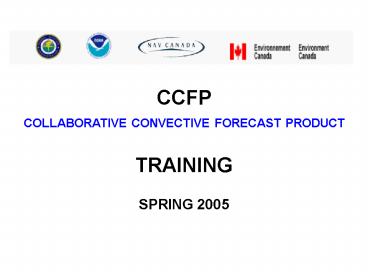CCFP - PowerPoint PPT Presentation
1 / 37
Title:
CCFP
Description:
... the primary weather forecast product for strategic ... Select weather dialog on CCSD. CCFP forecast map selection for the 2, 4 or 6 hour forecast overlay ... – PowerPoint PPT presentation
Number of Views:53
Avg rating:3.0/5.0
Title: CCFP
1
- CCFP
COLLABORATIVE CONVECTIVE FORECAST PRODUCT
TRAINING
SPRING 2005
2
Course Objectives
- Overview of CCFP
- Identify the upcoming changes for 2005 convective
season - Identify strengths and weaknesses, and what the
product can and can not do - Address misconceptions and issues encountered in
past convective seasons with the product - Review two case studies
3
Purpose Overview of CCFP
4
CCFP Background
- The 2005 convective season will be the start of
the 5th season to use CCFP operationally - CCFP is developed through a collaboration process
between meteorologists - All stakeholders have agreed that the CCFP is the
primary weather forecast product for strategic
planning on the Planning TELCON
5
CCFP What it is
CCFP
6
Canadian CCFP
7
CCFP What it is not
CCFP
8
CCFP Collaborators
9
CCFP Collaborative Process
- The chat sessions occur every two hours and are
completed prior to the planning telcon (PT) - AWC is committed to reading every comment
- The previous forecasts (4 and 6 hour forecasts)
will be used as preliminary forecasts for the
next 2 and 4 hour forecast - Except for the 1 a.m. forecast, which a new
preliminary forecast will be issued for the 6-hr
lead time.
10
CCFP Forecast Issuance Example
Comments
Valid Times (Eastern Time)
Supported Telcon (Eastern Time)
CCFP Issue (Eastern Time)
Collaboration Session Open (Eastern Time)
2, 4, 6 hour forecasts
05 - 07 - 09
-------
0300
0215 - 0245
2, 4, 6 hour forecasts
07 - 09 - 11
0515
0500
0415 - 0445
2, 4, 6 hour forecasts
09 - 11 - 13
0715
0700
0615 - 0645
2, 4, 6 hour forecasts
11 - 13 - 15
0915
0900
0815 - 0845
Note The previous 4 and 6 hour forecasts will be
used as preliminary forecasts for the 2 and 4
hour forecast
11
CCFP Collaborative Process, cont.
- The final package is completed by AWC and
includes the 2, 4 and 6 hour forecasts and posted
on the TSD and CCSD, as well as the AWC and
ATCSCC websites.
12
New 2005 TSD CCFP Graphic
13
Why Change the Graphic?
?
14
CCFP Display on CCSD
On the menu bar of the CCSD, click the weather
pull-down menu and choose select weather
15
Select weather dialog on CCSD
CCFP forecast map selection for the 2, 4 or 6
hour forecast overlay
16
New 2005 TSD CCFP Graphic (with detail)
17
Forecaster Confidence of Occurrence
18
CCFP Coverage Criteria
- Coverage (CVRG) Identify by degree of fill in
one of 3 categories for areas - Low 25-49 (Sparse Fill)
- Med 50-74 (Medium Fill)
- High 75-100 (Solid Fill)
- Solid line of convection (Purple)
19
CCFP Coverage Criteria
- Coverage (CVRG) Identify by degree of fill in
one of 3 categories for areas - Low 25-49 (Sparse Fill)
- Med 50-74 (Medium Fill)
- High 75-100 (Solid Fill)
- Solid line of convection (Purple)
20
Coverage Criteria Points to Remember
- An area, or single cell of convection with a
coverage of less than 25 will not be forecast
on the CCFP but may still impact the airspace,
but is normally handled as a tactical issue - Remember the criteria for an area of convection
on the CCFP is at least 3,000 sq. mi area with
coverage greater than 25, and echo tops greater
than 25,000 ft.
21
Coverage Criteria Points to Remember
- Coverage is NOT the chance of thunderstorm
development, but the percentage of area covered
by the convective activity
22
Review
- Two major changes to the 2005 CCFP
- Confidence is Color
- Low 25-49
- High 50-100
- Coverage is Fill
- Low 25-49 (Sparse Fill)
- Med 50-74 (Medium Fill)
- High 75-100 (Solid Fill)
(GRAY)
(BLUE)
23
CCFP Interpretation - 1
24
CCFP Interpretation - 2
25
CCFP Interpretation - 3
26
CCFP Data Block
DATA BLOCK
27
CCFP Movement
28
CCFP Tops Criteria
- TOPS
- Echo tops within the forecast area are reported
in the following three categories - 25,000-31,000 feet MSL
- 31,000-37,000 feet MSL
- Above 37,000
- Echo top of 25,000 feet Mean Sea Level (MSL), or
greater, are expected to cover at least 25 of
the forecast area
29
CCFP Growth
30
2005 CCFP Schedule
Note UTC is 5 hours ahead of Eastern before
Daylight Savings (April 3, 2005), and 4 hours
ahead of Eastern time during Daylight Savings
31
CCFP DATA VERIFICATION
http//www-ad.fsl.noaa.gov/fvb/rtvs/conv/index.htm
l
32
Scenario 1 Aug 10, 2004
33
Scenario 1 Aug 10, 2004
34
Scenario 1 Aug 10, 2004
35
Chat Log Area
- Remember - the chat logs and the PT telcons are a
great resource if you have time to gather that
extra information - The chat logs can be found on the AWC website at
- http//aviationweather.gov/products/ccfp/logs
- You may want to have your supervisors print the
logs if you know there will be significant
weather to deal with
36
CONCLUSIONS
- CCFP intended as a long range (2-6 hour)
strategic forecast not as a tactical tool - The graphic was changed to give TMCs a more of a
quick glance overview of the weather forecast - Confidence is Color
- Low 25-49
- High 50-100
(GRAY)
(BLUE)
37
CONCLUSIONS
- Coverage is Fill
- Low 25-49 (Sparse Fill)
- Med 50-74 (Medium Fill)
- High 75-100 (Solid Fill)
- CVRG is the percentage of area coverage NOT the
chance of thunderstorm (TSTM) development






























